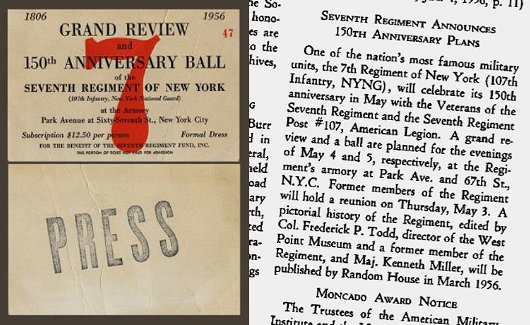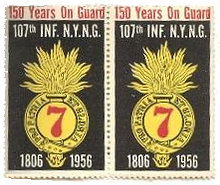
About Andrew Cusack
 Writer, web designer, etc.; born in New York; educated in Argentina, Scotland, and South Africa; now based in London.
Writer, web designer, etc.; born in New York; educated in Argentina, Scotland, and South Africa; now based in London. read more
News
Blogs
Reviews & Periodicals
Arts & Design
World
France
Mitteleuropa
Knickerbockers
Argentina
The Levant
Africa
Cape of Good Hope
Netherlands
Scandinavia
Québec
India
Muscovy
Germany
Academica
200 Years was an Empty Anniversary for New York’s ‘Gallant Seventh’

Flipping through a military journal from early 1956, I stumbled upon a rather depressing note announcing the Seventh Regiment’s plans for celebrating its 150th anniversary. A reunion of old comrades on Thursday May 3, then a grand review the following day, and topped off by a formal ball on the evening of Saturday May 5 at the regiment’s beautiful armory on Park Avenue at 67th Street.
 Why should such a splendid celebration spark dour thoughts? Chiefly because, having survived over a century and a half since the unit was founded amidst pints of ale in the Shakespeare Tavern on the corner of Nassau and Fulton, the Seventh Regiment was abolished before it could celebrate its 200th anniversary in 2006. The Seventh was deactivated as a regiment in 1993, though its “lineage” was transferred to the 107th Corps Support Group, which in 2006 was “consolidated” into the 53rd Army Liaison Team. The regiment’s unique collection of historical artifacts — the legal property of the Veterans of the Seventh Regiment — was seized by the State in an act of highly dubious constitutionality and its armory, built without a cent of public money from the pockets of the regiment’s members in the 1880s, was also taken and transferred to a conservancy to run it as an events & performing arts venue, over protests from both veterans groups and the local community.
Why should such a splendid celebration spark dour thoughts? Chiefly because, having survived over a century and a half since the unit was founded amidst pints of ale in the Shakespeare Tavern on the corner of Nassau and Fulton, the Seventh Regiment was abolished before it could celebrate its 200th anniversary in 2006. The Seventh was deactivated as a regiment in 1993, though its “lineage” was transferred to the 107th Corps Support Group, which in 2006 was “consolidated” into the 53rd Army Liaison Team. The regiment’s unique collection of historical artifacts — the legal property of the Veterans of the Seventh Regiment — was seized by the State in an act of highly dubious constitutionality and its armory, built without a cent of public money from the pockets of the regiment’s members in the 1880s, was also taken and transferred to a conservancy to run it as an events & performing arts venue, over protests from both veterans groups and the local community.
Though almost all the military functions which took place in this magnificent building have now been moved elsewhere, at least the 53rd ALT and the Veteran Corps of Artillery are allowed to maintain a presence in the building. The conservancy, however, has rebranded the building as the “Park Avenue Armory”, disgracefully erasing the long history of the regiment from the building’s name.
One obviously hopes for the regiment to be swiftly reestablished and for the regimental collection to be returned to its rightful owners, the Veterans of the Seventh Regiment. But there seems to be a continual mysterious spirit in New York that anything that is old, traditional, or good must somehow be assaulted, driven underground, or ultimately destroyed. I won’t be placing any bets that these historical wrongs will ever be righted.

Search
Instagram: @andcusack
Click here for my Instagram photos.Most Recent Posts
- Bicycle Rack April 29, 2024
- Burns Tower April 19, 2024
- Patrick in Parliament March 18, 2024
- Articles of Note: 13 March 2024 March 13, 2024
- Cambridge March 9, 2024
Most Recent Comments
Book Wishlist
Monthly Archives
Categories



Andrew, You are of course correct about the rebranding of the building. It gets a bit more dicey when it comes to the question of who owns the historical artifacts. I remember reading the court decision on this topic–it was difficult to read it and remain on the side of the veterans’ group. I say this as one who approached the topic on the assumption that I would side with the veterans over the position of NY State.
If I recall correctly, the State objected (in the 2000’s) to the transfer of the collection from the Regiment (a subsidiary of the State) to the Veterans (a non-State association) that took place in the 1950’s. Ordinarily this objection would be outside the statute of limitations, but the State argued the ancient principle of “the King has no time” — the statute of limitations cannot restrict the Sovereign.
There arises an interest constitutional situation in which the State is not the Sovereign, but rather the People of the State of New York are, and the State is presumed to be the embodiment (or whatever the term might be) of the said People. I think trying to argue a wedge between the People-as-Sovereign and the State-as-agent-of-sovereignty is probably a useless one.
A better case might be made that the State de facto deprived the Veterans of property without proper compensation.
The collection is certainly the moral, rightful property of the Veterans, but whether it is the legal property, I’ll admit, is a bit murkier. I personally think the Act confiscating the collection is a crime against natural law and thus worthy of being thrown out on those grounds alone.
“but the State argued the ancient principle of “the King has no time” — the statute of limitations cannot restrict the Sovereign.”
Except those circumstances in which the Sovereign has voluntarily submitted itself to the Statute of Limitations. I know the State of New York submits in some cases, but I cant remember what they are.
“But there seems to be a continual mysterious spirit in New York that anything that is old, traditional, or good must somehow be assaulted, driven underground, or ultimately destroyed.”
Andrew, thank you for an interesting file. I find unfortunately that the “continual mysterious spirit” is more pervasive than just in New York!
Andrew, You are right that the statute of limitations played a major role in the case. My memory could be off, but in order for the veterans group to prevail on the statute of limitations, I think they had to take the position that the action taken in the 1950s by the veterans was outright theft. If it was instead done under a color of right, then the State would win the issue. So the venterans in the 2000s were in the extremely awkward position of having to assert that their predecessors in the 1950s acted as theives. All very strange, very sad.
On an unrealted topic, I hope you are doing something appropriate to mark Lenin’s 139th Birthday (sometimes also called Earth Day).
The spirit is Liberalism. It hates everything old, traditional, historic, elitist, or WASP.
The 7th Regiment was magnificently all of these. So of course it had to go.
The historic peoples who created the USA are soon to be a minority in their own country. Some individual states may survive in a form in some way akin to what they were in the past, but the USA will not.
“The regiment’s unique collection of historical artifacts . . . was seized by the State in an act of highly dubious constitutionality . . .”
How interesting, since it undeniably was an overwhelmingly unconstitutional invasion that the Regiment assisted in the “Civil War” commemorated in the stained glass window shown. Funny thing those constitutions: you tear a little away when it mainly hurts someone other than you, and next thing you know the tear starts spreading until the whole document lies in tatters; and now the pain finds its way even to those who themselves earlier tore at the document with impunity. Oh well . . .